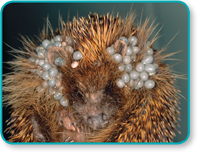Parasitism and Disease Parasites and disease-causing organisms feed at the expense of their hosts, weakening them and often causing disease or death. The ticks on the hedgehog in Figure 5–9, for example, can carry diseases. Parasitism and disease are density-dependent effects because the denser the host population, the more easily parasites can spread from one host to another.
If you look back at the graph in Figure 5–8, you can see a sudden and dramatic drop in the wolf population around 1980. At that time, a viral disease of wolves was accidentally introduced to the island. This virus killed all but 13 wolves on the island—and only three of the survivors were females. The removal of wolves caused moose populations to skyrocket to 2400. The densely packed moose then became infested with winter ticks that caused hair loss and weakness.
Stress From Overcrowding Some species fight amongst themselves if overcrowded. Too much fighting can cause high levels of stress, which can weaken the body's ability to resist disease. In some species, stress from overcrowding can cause females to neglect, kill, or even eat their own offspring. Thus, stress from overcrowding can lower birthrates, raise death rates, or both. It can also increase rates of emigration.

FIGURE 5–9 Parasitism The ticks feeding on the blood of this hedgehog can transmit bacteria that cause disease.
Density-Independent Limiting Factors
 What limiting factors do not typically depend on population density?
What limiting factors do not typically depend on population density?
Density-independent limiting factors affect all populations in similar ways, regardless of population size and density.  Unusual weather such as hurricanes, droughts, or floods, and natural disasters such as wildfires, can act as density-independent limiting factors. In response to such factors, a population may “crash.” After the crash, the population may build up again quickly, or it may stay low for some time.
Unusual weather such as hurricanes, droughts, or floods, and natural disasters such as wildfires, can act as density-independent limiting factors. In response to such factors, a population may “crash.” After the crash, the population may build up again quickly, or it may stay low for some time.
For some species, storms can nearly extinguish local populations. For example, thrips, aphids, and other insects that feed on leaves can be washed out by a heavy rainstorm. Waves whipped up by hurricanes can devastate shallow coral reefs. Extremes of cold or hot weather also can take their toll, regardless of population density. A severe drought, for example, can kill off great numbers of fish in a river, as shown in Figure 5–10.
True Density Independence? Sometimes, however, the effects of so-called density-independent factors can actually vary with population density. On Isle Royale, for example, the moose population grew exponentially for a time after the wolf population crashed. Then, a bitterly cold winter with very heavy snowfall covered the plants that moose feed on, making it difficult for the moose to move around to find food.
MYSTERY CLUE 
What factors do you think could limit the size of a rabbit population?
Table of Contents
- Formulas and Equations
- Applying Formulas and Equations
- Mean, Median, and Mode
- Estimation
- Using Measurements in Calculations
- Effects of Measurement Errors
- Accuracy
- Precision
- Comparing Accuracy and Precision
- Significant Figures
- Calculating With Significant Figures
- Scientific Notation
- Calculating With Scientific Notation
- Dimensional Analysis
- Applying Dimensional Analysis




